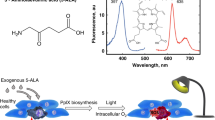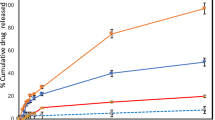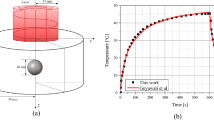Abstract
A chemical extraction assay and fluorescence microscopy incorporating a light-sensitive thermoelectrically cooled charge-coupled device (CCD) camera was used to study the kinetics of uptake, retention and localisation of disulphonated aluminium phthalocyanine (A1PcS2) and tetrasulphonated aluminium phthalocyanine (A1PcS4) at different time intervals after an i.p. injection at a dose of 10 mg kg-1 body weight (b.w.) in tumour and surrounding normal skin and muscle of female C3D2/F1 mice bearing CaD2 mammary carcinoma. Moreover, the photodynamic effect on the tumour and normal skin using sulphonated aluminium phthalocyanines (A1PcS1, A1PcS2, A1pcS4) and Photofrin was compared with respect to dye, dye dose and time interval between dye administration and light exposure. The maximal concentrations of A1PcS2 in the tumour tissue were reached 2-24 h after injection of the dye, while the amounts of A1PcS4 peaked 1-2 h after the dye administration. A1PcS2 was simultaneously localised in the interstitium and in the neoplastic cells of the tumour, whereas A1PcS4 appeared to localise only in the stroma of the tumour. The photodynamic efficiency (light was applied 24 h after dye injection at a dose of 10 mg kg-1 b.w.) of the tumours was found to decrease in the following order: A1PcS2 > A1PcS4 > Photofrin > A1PcS1. Furthermore, photodynamic efficacy was strongly dependent upon dye doses and time intervals between dye administration and light exposure: the higher the dose, the higher the photodynamic efficiency. The most efficient photodynamic therapy (PDT) of the tumour was reached (day 20 tumour-free) when light exposure took place 2 h after injection of A1PcS2 (10 mg kg-1). A dual intratumoral localisation pattern of the dye, as found for A1PcS2, seems desirable to obtain a high photodynamic efficiency. The kinetic patterns of uptake, retention and localisation of A1PcS2 and A1PcS4 are roughly correlated with their photodynamic effect on the tumour and normal skin.
This is a preview of subscription content, access via your institution
Access options
Subscribe to this journal
Receive 24 print issues and online access
$259.00 per year
only $10.79 per issue
Buy this article
- Purchase on Springer Link
- Instant access to full article PDF
Prices may be subject to local taxes which are calculated during checkout
Similar content being viewed by others
Author information
Authors and Affiliations
Rights and permissions
About this article
Cite this article
Peng, Q., Moan, J. Correlation of distribution of sulphonated aluminium phthalocyanines with their photodynamic effect in tumour and skin of mice bearing CaD2 mammary carcinoma. Br J Cancer 72, 565–574 (1995). https://doi.org/10.1038/bjc.1995.375
Issue Date:
DOI: https://doi.org/10.1038/bjc.1995.375
This article is cited by
-
Enhanced photodynamic destruction of a transplantable fibrosarcoma using photochemical internalisation of gelonin
British Journal of Cancer (2005)
-
Photosensitized Inactivation of Cyst Forms of the Freshwater Amoeba Vahlkampfia hartmanni by Aluminium (III) Phthalocyanine Tetrasulfonate
The Environmentalist (2005)



